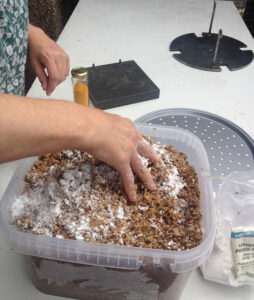Post written by Cath Keay

As with Carnevale, we began by discussing toys and games designed for children that might be adapted for pigs. We mulled over building blocks that could be stacked, bead-like objects strung in chains, or interlocking construction toys, and then settled on a notched circular form which could be easily reproduced, then slotted together like a rudimentary cactus.


We tested various mixes of spent beer mash and binding agents such as cornstarch, wheat flour, potato starch and carrageenan. However, there are concerns about how safe carrageenan is for pigs, and research papers suggest that potato starch helps their digestion, so we have gone with that. The mixture requires pressure to bind the material, so we tried using a briquette maker- a metal contraption sold to convert newspapers into fuel, which proved very unfit for this purpose. We took a lead from an online video showing how encaustic tiles are made by compressing cement powder in a hydraulic press, then we approached UoE’s Engineering Department at Kings Buildings where Mark and Andy, the technicians, showed us how to put five tonnes of pressure on each biscuit.


Barney’s Beer microbrewery gave us a batch of mash that contained rye, and this proved to be the best mix for biscuits that retain their notched form so that they can interlock in modular chains. The rye produces more durable biscuits; able to withhold the attention of a dozen curious pigs for longer too.
We made two sizes of former and so we will soon produce a batch of smaller (funsize) Hognobs using wheat and rye mix. We will then test both versions with the pigs at Gorgie Farm and document the pigs’ reactions to these enrichment objects.

Photography © Andrea Roe
(copyright Andrea Roe)
(Copyright Andrea Roe)
(Copyright Andrea Roe)
(Copyright Andrea Roe)
(copyright Andrea Roe)
(Copyright Andrea Roe)
(Copyright Andrea Roe)


